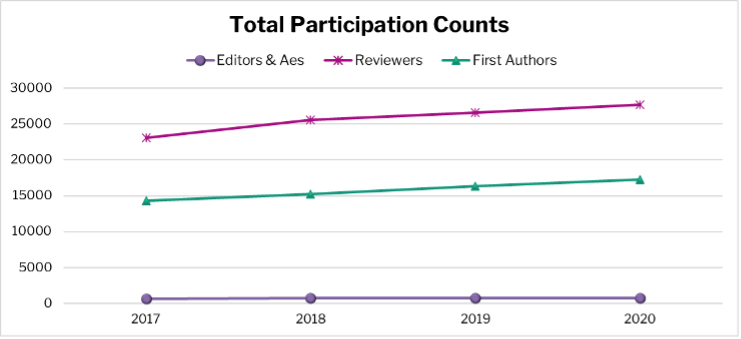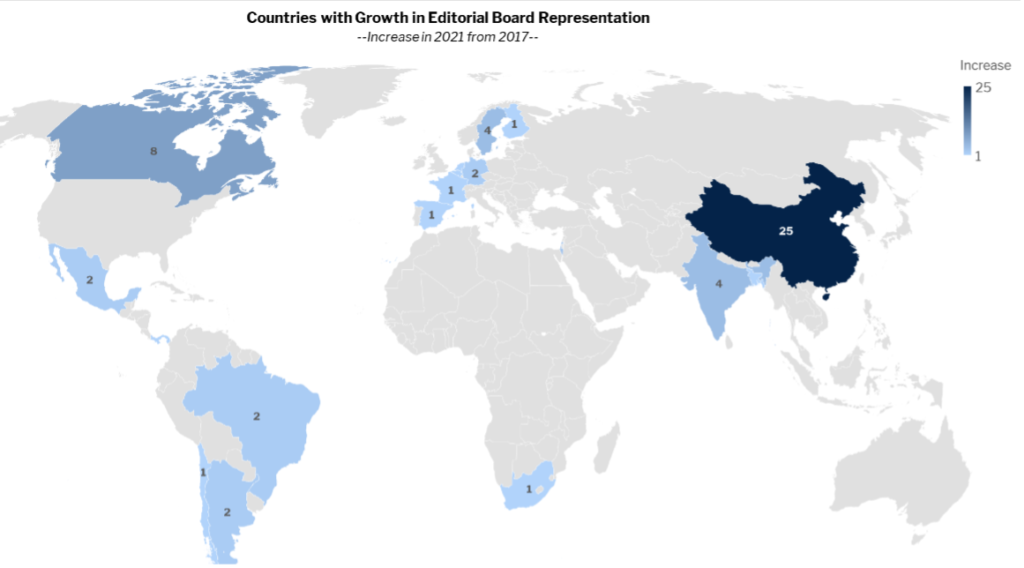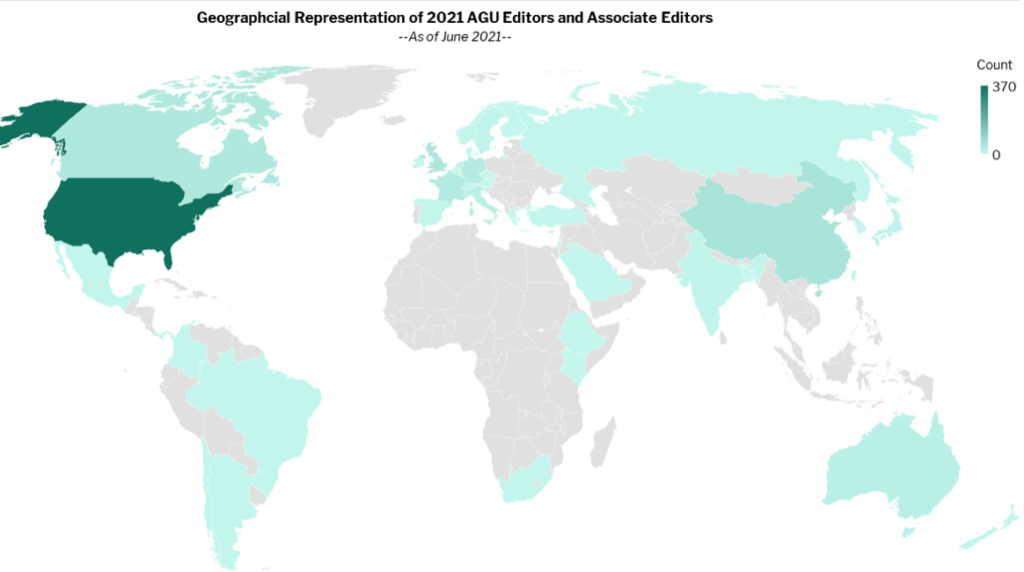Editor’s Note: Today’s post is by Matt Giampoala, Randy Townsend, and Paige Wooden. Matt serves as the Vice President for Publications for the American Geophysical Union (AGU) where he oversees its journals, books, and preprint programs. Matt has led efforts in expanding access and engagement through open science and reproducibility initiatives and is an advocate for promoting equity and inclusion in scholarly publishing. Randy sits on the Board for the Society of Scholarly Publishing, the Advisory Board for the AM&P Network’s Association’s Council, is the Chair for CSE’s Webinar Subcommittee, and on ISMTE’s Programming Committee. Randy is the inaugural Editor-in-Chief for the GW Journal of Ethics in Publishing and an Associate Professor for the MPS in Publishing program at George Washington University. Paige serves as Senior Program Manager, Publication Statistics for the American Geophysical Union (AGU). She works on data projects on editorial operations, post-publication metrics, and member data to inform department and enterprise strategy.
This year marks 125 years that the American Geophysical Union’s (AGU’s) publications have been in operation. The foundation of AGU’s 22 journals and portfolio of books is built on the long tradition of robust peer review. While we at AGU are committed to peer review’s value in strengthening and deepening scientific discourse, there are elements embedded in our traditional practices that need revision to ensure that scientific discourse is truly inclusive and beneficial for all. A major pillar of AGU’s strategic plan is promoting and exemplifying an inclusive scientific culture. This includes the way in which we conduct peer review.
AGU is, like most scholarly publishers, committed to reducing reviewer fatigue, expanding reviewer pools, and diversifying the representation of our volunteer referees. We recently launched a Co-Reviewer pilot program to offer guidance and mentorship to early career researchers and new contributors, and to attract qualified referees who might have been unsure how to get involved. As the mantra of “following the science” is increasingly used to legitimize key decisions impacting society at large, it elevates the urgency to protect the integrity of our process so that it remains both uncompromised and inclusive.
When we are more inclusive at all levels, we not only have better outcomes, but the benefits of scientific research are more widely shared and accessible. Throughout our history, AGU has attracted individuals from around the world and continues to expand services provided to the community of 130,000 enthusiasts and experts worldwide in Earth and space sciences that we support. The journey toward maximizing participation and access from diverse contributors involves evaluations of our activities and acknowledgment of the important work that lies ahead. In this post we share information from this evaluation.
Reviewer Demographics
To chart our course forward, we must first understand our current state and trajectory. AGU has been monitoring and reporting reviewer demographics for the past five years to determine a baseline and develop goals for reviewer diversity (e.g., in Lerback & Hanson, 2017). This curation and analysis merge our editorial data with our membership data, where most members have provided their gender identity and year of birth, and some have provided their race/ethnicity. Age data are critical to understand data on participation and biases. Data on age and career stage can also help us understand the trajectory of our demographic changes.
We’ve been especially focused on increasing the representation of women, early career, and international scientists in our invited reviewer pool. Though some worry that reviewing is a “thankless” volunteer activity that could distract from pursuing tenure, it can positively impact one’s career, including increasing visibility for more prestigious opportunities such as editing, exposure to the latest emerging research, and improving writing and editing skills.
We’ve found that using metrics also helps to reveal clear targets for our chief editors as they invite editorial board members who in turn invite reviewers. There are a few ways that we envision our ideal reviewer pool: first, it should align with the demographic distribution of authors of accepted papers, which consists of higher proportions of non-Western scientists than the current reviewer pool. For instance, when we present data that reflects an imbalance between the percentage of authors from China and the lack of editors and associate editors from this country, it exposes a clear gap that our chief editors can work toward closing. Second, the reviewer pool should more closely mirror AGU member demographics, which consist of higher proportions of women and early career scientists than the reviewer pool.
Our first approach in establishing a baseline for our reviewer pool was to collect a rich cadre of demographic data from which we could begin to draw statistically significant conclusions. Author and reviewer country data come from manuscript submission system profiles. If no country is listed, we can sometimes use an email suffix to inform assumptions. In 2020, 97% of reviewers had country data.
Gender data are acquired from our member database, and for those without a member profile, we use the third-party gender API, which returns a binary gender based on the first name and country. In 2020, the AGU member profile provided the gender option “non-binary,” which has been used several times. We have gender data on 87% of our 2020 invited reviewers.
Race/ethnicity and age also come from the AGU member profiles, but race/ethnicity options were previously based on U.S. citizenship, so we have a low reporting rate for non-U.S. members. 22% of all invited reviewers in 2020 and 49% of U.S.-based reviewers had race/ethnicity data and 68% of invited reviewers had known age.
Expanding gender and geographical diversity
Based on membership and other data collected, AGU has been successful in expanding gender and geographical diversity on the editorial boards of our 22 journals and books to help improve the diversity of the reviewer pool.


One consequence of increasing editors in countries with lower proportions of women scientists is that it could affect the proportion of women editors overall. Despite this trend, we have increased the percentage of women editorial board members by about 20% since 2012 (not shown in graph), now comprising almost 40% of our editorial board members (Figure 2) which is quickly exceeding 700 leading geoscientists of all genders. The first graph shows the increase in proportion of women participating in various AGU roles; note that the proportion of women editors and associate editors exceed the proportion of women members. We’ve seen slight decreases in the proportion of women first authors and reviewers due to the increase in global participation of men and people of unknown gender, but in 2020, the number of women authors and reviewers has increased by more than 1,000 each since 2017. For additional context, the second graph shows total participation as authors and reviewers is increasing.


We’ve focused on increasing geographical representation especially among editors in China and India as they continue to increase their geoscience output. We’ve also added editorial board members from Mexico, Central, and South America. The first map shows the increase in number of editors and associate editors from countries seeing growth since 2017. The second map shows the location of our current editors and associate editors (by country of address).
Expanding diversity among our editors has the potential to produce ripples in other areas of scholarly communication and peer review.
Racial diversity of our editorial boards
We’ve had modest increases in the number of editors identifying as non-white since 2017, specifically among African American, Asian American, and Latinx geoscientists. Increasing diversity of viewpoints among people influencing what gets published and becomes a part of the scientific record is just as important as increasing diversity of our editors, invited reviewers and authors attracted to our journals.
Expanding racial diversity among our editorial boards presents us with a different set of circumstances and considerations. The complexities of looping a Senegalese researcher from the UK studying in Boston under the umbrella of ‘African American’ can produce inaccurate results, and our demographic taxonomy is in need of a tune-up. AGU has completed work under the advisement of its Diversity and Inclusion Advisory Committee to broaden our demographic taxonomy beyond US census categories so that people will no longer be relegated to the “other” category. With regards to racial diversity of our editorial boards, we are making progress, but we recognize that we still have some miles ahead of us.
All this work is being informed by organizations and coalitions across scholarly publishing. AGU’s Publications Committee and Diversity and Inclusion Advisory Committee offer guidance for our policies and efforts to diversify our editorial boards. C4DISC and their supporting members are doing valuable work, most recently through the antiracism toolkits. In addition, AGU has learned much from participation in the Joint Commitment for Action on Inclusion and Diversity in Publishing. Members work together to create standards and best practices for demographic data collection and policies. The members of the Joint Commitment aim to pool data to give us as complete a picture as possible as we work toward our common goal.
Next Steps: Community Science
Many of the above activities, while necessary, amount to slow incremental change of our programs. We also see the need to try something radically different to accelerate our progress.
With this in mind, AGU is excited to collaborate with four society partners to launch a new publication and portal called Community Science. We envision a space where science is channeled toward the needs of regional and local communities and is driven by members of those communities to address their priorities. To succeed, we must break down barriers to participation as well as barriers across disciplines. Community Science will be a place where communities are not just invited to read about scientific discoveries and solutions but are involved at all stages. The platform will promote learning and sharing about how to engage in community science; connect with potential partners in this work; and serve as an exchange for data and resources. We’ll reimagine peer review models and include more perspectives by creating a participant review process that will ensure usefulness of all articles and reports as well as other materials and resources.
We’re working with the social and health sciences to ensure that the research will have the broadest possible impact on policy and local community applications. The platform will extend the concept of peer-review beyond science by inviting community leaders to participate and including reviewing for integrity in community science. Editors from some of these important perspectives will not have traditional academic incentives to take part in peer review, so we are seeking funding to support their participation.
This Peer Review Week, we proudly honor our editors and reviewers for their commitment to developing a more inclusive and equitable peer review system. The existing challenges that disrupt our journey pale in comparison to the opportunities achieved through diverse representation. We look forward to continuing our work with all stakeholders to make sure this becomes a reality.
Discussion
2 Thoughts on "Guest Post — Why the “Who” of Peer Review is Important"
It is not clear to me why in a hard science like this there is any reason to be concerned about diversity in the ethnic, gender, age, and geographic makeup of the reviewer pool. As a longtime editor in the social sciences I can understand why such diversity might be relevant; there is an argument to be made there that lived experience can enrich and deepen a purely academic understanding of the subject matter. But in natural science I shuld think that the only diversity that should matter is viewpoint diversity.
That’s a toughie. Throughout life, “lived experience” has helped us to adjust our perception to accommodate views about age, sex, ethnicity and other criteria. These perceptions pop up in all areas of life – personal and professional. I doubt that the “hard” sciences are ring-fenced from that
